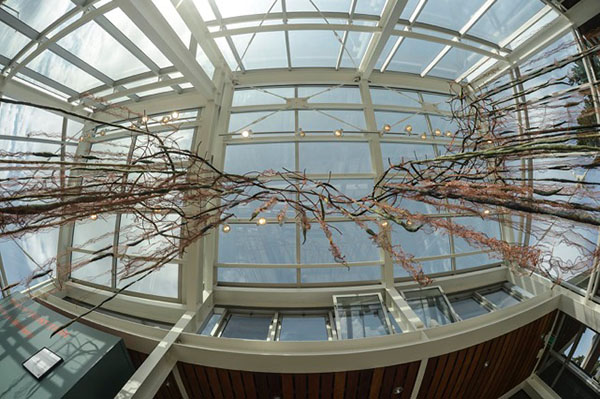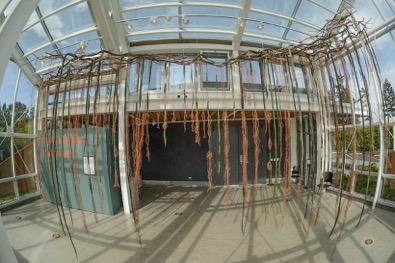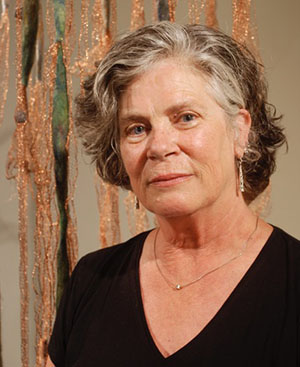— from Diane Martindale for San Juan Islands Museum of Art —

Looking up through this art installation, we are presented the illusion of being submerged midst the kelp, under water. Changing light throughout the days alters he mood of this very tactile art at the San Juan Islands Museum of Art (SJIMA). We are challenged by the installation, Tide of
Transition, designed by Cathryn Mallory of Missoula, MT. She intends for the Atrium to be a space for reflection on the beauty and function of marine plant forms of the Pacific Northwest.
She presents a kelp bed to highlight its value as a nursery for plant and sea life and as a sustainable energy and carbon-neutral food source. Bob Durden, former Curator, Paris Gibson Square Museum of Art, described her exhibition Trace Identity thus, “Like many artists working today, Cathryn Mallory rejects the abandonment of beauty and instills beauty into her work through the use and command of her materials and the forms that she chooses to create. For her, to make something beautiful reflects a positive outlook on life.”
Mallory uses a variety of skills and materials to build this seductive, touch-able environment. From her textile background, she hand-felts wool and weaves, wraps, binds and twists fibers and copper mesh to her will. Wool protects sheep, humans and homes mirroring a function of kelp beds which provide protection, habitat and nutrition for aquatic life.

When interacting with wool and water, she fashions felt from a process like moving kelp in the sea. She uses copper, a healing material which provides energy reflecting traits of a kelp bed.
Though labor intensive, the process of hand making the basic elements of the installation is an intuitive and reflective process, incorporating subconscious inspiration into the final work. Tide of Transition relates industrial and domestic materials resulting in plant forms with contrasting structures.
Also, at SJIMA by Robert Dash is FOOD FOR THOUGHT, Micro Views: Threats and Prospects offers a micro perspective on how one part of nature–our food–is connected to climate change. Cathryn Mallory relates to his exhibition by directing our eye to the beauty and patterns of the ecosystem.

Cathryn Mallory is a Professor and Director of the Gallery of Visual Arts for the School of Art at The University of Montana. She received her BFA in fiber arts from Northern Illinois University and MFA in sculpture fro the University of Oklahoma.
Museum hours are Friday-Monday, 11-5. Mondays are Pay As You Can Days. Admission is $10, with members and those 18 and under free. Go to www.sjima.org for more information. SJIMA is located at 540 Spring Street in Friday Harbor.
**If you are reading theOrcasonian for free, thank your fellow islanders. If you would like to support theOrcasonian CLICK HERE to set your modestly-priced, voluntary subscription. Otherwise, no worries; we’re happy to share with you.**







